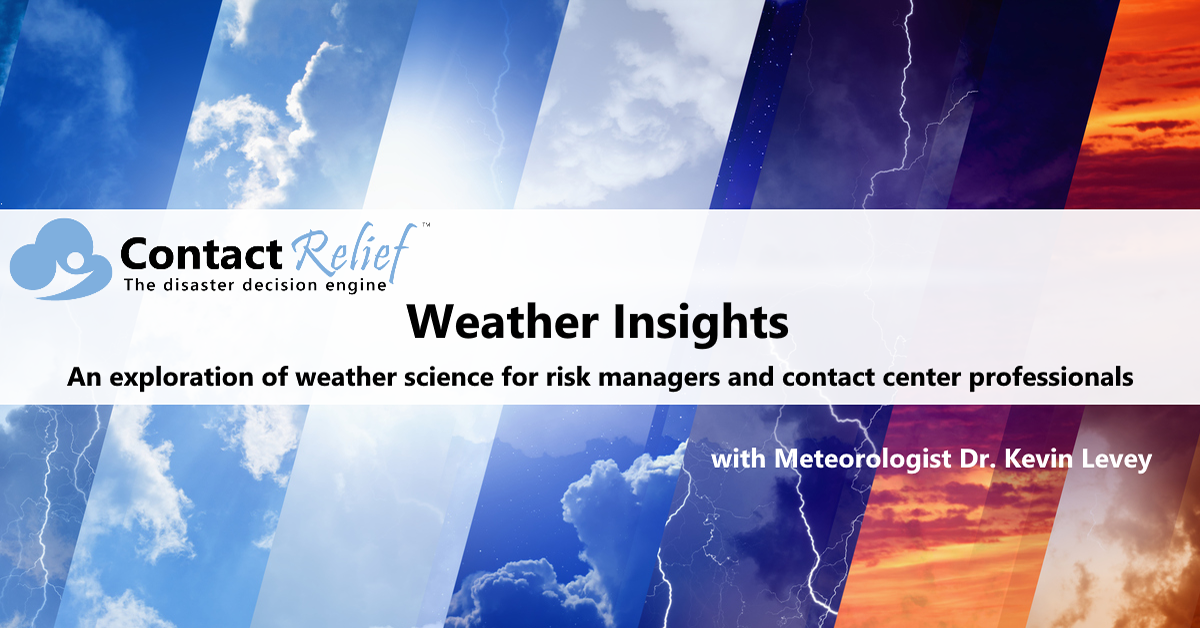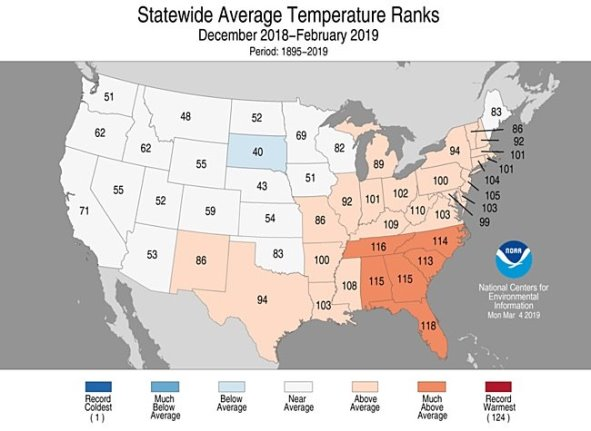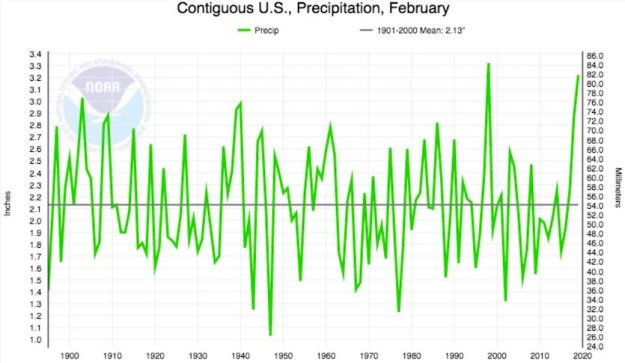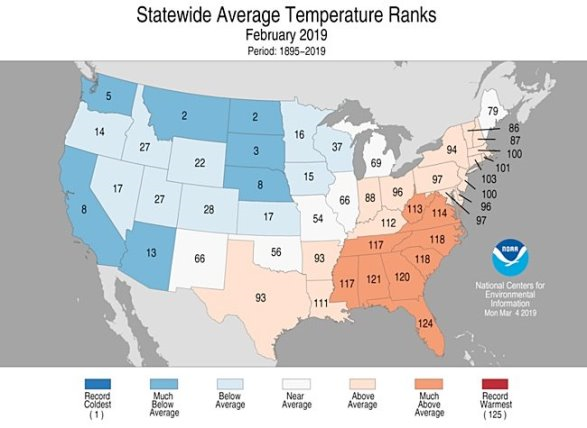
Who Ordered the Rain?
2019 was the Wettest Winter Ever
Wednesday, 13 March 2019 05:00:00 -05:00
Meteorological winter comprises the months December, January and February, and this past winter was the wettest on record in the contagious United States and 2nd wettest February since comprehensive records began – some 124 years – this according to a report just released by NOAA’s National Centers for Environmental Information (NCEI).
Across the three months of meteorological winter (December-February), the nationally averaged precipitation was 9.01”, just above the old record of 8.99” from 1997-98. That winter’s precipitation was aided by a record-strong El Niño event, as was the case in 1982-83 (the fifth wettest winter on record) and 2015-16 (the fifteenth wettest). This past winter saw only borderline El Niño conditions, though.
This winter’s moisture was well distributed, with most of the nation wetter than average. Leading the pack were states east of the Rockies, where heavy snows and torrential rains fell time and again on the north and south sides of a persistent storm track from the Southern Plains to New England. Tennessee had its wettest winter on record, and 18 other states had top-ten wettest winters as shown below inFigure 1.
It hasn’t just been this past winter that has been so wet - the last 12 months have been the wettest March-to-February period on record, with a nationally averaged 35.67” of precipitation. Only two other 12-month periods at any time of year have been wetter: May-April 2015-16 (35.95”) and April-March 2015-16 (35.78”). The past year’s precipitation totals were pushed up not only by the record-wet winter but also by Hurricane Florence in September, which was ranked as the nation’s second wettest storm of the past 70 years, behind only Hurricane Harvey of 2017.
With record rainfall across the country, drought concerns have diminished over much of the contiguous United States. The weekly U.S. Drought Monitor report released on February 28 showed just 12% of the nation experiencing drought of any intensity (levels D1 to D4), the lowest extent since August 2017. A small pocket of northern New Mexico remained at extreme or exceptional drought (D3-D4), with less-intense drought still affecting much of the Great Basin. I pointed this out 2 weeks ago.
Despite periods of intense drought in recent years, especially over the Desert Southwest—with the impacts worsened by rising temperatures—the overall trend over the last century has been toward wetter U.S. conditions. The 48-state annual precipitation average is now around 31” compared to 29” a century ago.
The turn toward frigid conditions across much of the U.S. in February failed to counterbalance unusual warmth in December and most of January, which left meteorological winter on the mild side compared to all winters since 1895. This was the 38th warmest of the past 124 winters, according to NCEI. South Dakota was the only state that fell significantly below average on temperature, while four states across the Southeast had a top-ten-mildest winter (see Figure 2 below)
A preliminary all-time state record low was set on January 31 when Mount Carroll, Illinois, dropped to –38°F, yet Illinois still ended up with its 33rd mildest December-to-February period on record. This may be a good example of where memories of a given winter will be shaped more by a single intense event rather than by the three-month statistical average.
Last month was not quite wet enough to rank as the wettest February on record. The nationally averaged total of 3.22” fell just behind the 3.32” from 1998. Still, it was a remarkable month for Northwest snowfall and mid-South rainfall. Echoing the rankings for winter as a whole, Tennessee had its wettest February on record, and 18 other states saw top-ten-wettest Februaries (see Figure3 and 4 below).
Colder-than-average conditions across the West and Midwest helped ensure that the unusually wet conditions led to extremely high snowfalls. At least 24 locations from California to Michigan had their snowiest February on record. In Eau Claire, Wisconsin, the monthly total of 53.5” buried not only the previous February record (28.2” in 1936) but also the record for any month (35.3” in January 1929). The Midwest snowpack raises concerns for flooding across the region should the spring warmup arrive suddenly, especially if it’s accompanied by heavy rain. Among the towns and cities with massive snowfall in February were Omaha, Nebraska (46.1”, a February record), and Nome, Alaska (69.8”, second snowiest for any February). Last month also brought some very impressive rainfall records, triggered by several intense multiday downpours. Nashville, Tennessee, ended up with 13.47”, more than an inch above its longstanding February record of 12.37” from 1880. Tupelo, Mississippi, also had its wettest February, with 15.61”, but the record that it doused was set just last year (12.98” in 2018).
The intense cold wave that kicked off February in the Midwest quickly yielded to unusual warmth, but recurrent bouts of less-intense cold led to a chilly month overall in the West and Upper Midwest. Six states had a top-ten-coldest February (See Figure 5 below). In Glasgow, Montana, the only February colder than last month was in 1936 (a year that went on to produce the city’s hottest July on record).
Meanwhile, repeated surges of mild, moist air gave the seven states from Tennessee and North Carolina southward a top-ten-warmest February. On Feb. 7, Atlanta, Georgia, saw its earliest 80°F reading for any year in records going back to 1879 and on Feb. 19, Naples, Florida, saw its first 90°F ever recorded prior to March 6 in 77 years of recordkeeping.
Definitely a winter to remember and one for the record books!
What can ContactRelief do for you?
Are you ready to see how ContactRelief can shape your disaster operations strategy? Schedule your customized demo to see firsthand how ContactRelief can reduce your workload, protect your brand and improve your contact efficiency.




